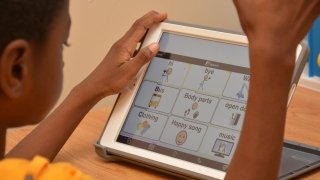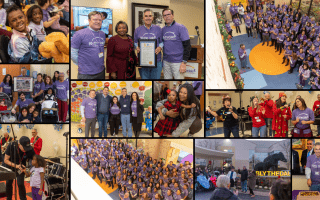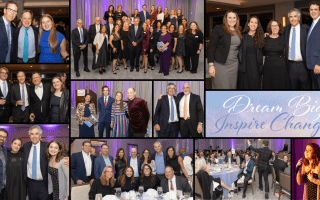Hear My Voice, Watch Me Move - Assistive Technology and Children
- Larry Levine, President & CEO

Some children live locked in silence. Though they have so much to say, they cannot speak. Some cannot move or control much of their bodies. Others face a grim future of gradual loss of speech or movement, or both. They have had strokes or accidents; they face neurological conditions or degenerative neuro-muscular disorders. But whatever their diagnosis, they are still children. They want to reach out to the world and share their feelings, thoughts and wishes; let you know when they're thirsty, happy or in pain; participate in class, listen to their music, email their friends and say "I love you" to their parents. And they want to move, play and gain as much independence as they can.
Assistive technology enables them to do all these things. It is equipment that improves the functional capabilities of a child with a disability, at school, home, and in the community. It supports a child in the functions of daily life, and makes communication and movement easier--or even possible.
Assistive technology is, essentially, the opening of a door for a locked-in child.
A few examples:
- A little boy with autism finally speaks through his voiced keyboard, and tells a toy car to "Go!" His eyes light up as it zips across the room.
- A child with no movement in his arms or legs zooms down the hall to visit his friends in a motorized wheelchair he controls with subtle movements of his head. Another sensor in the chair interfaces with his computer, so he can do his schoolwork and send emails.
- A girl with a degenerative disease learns to use her eyes alone to form words that are voiced on her specialized computer, so that her world will not close up when she can no longer speak. Each millisecond, a special built-in camera registers exactly where on the screen she is focusing. The computer processes these images and speaks the words she creates and phrases she selects with her gaze.
- A teenager who has lost speech and most movement after an accident slowly drags a finger to a large, ultra-sensitive joystick that lets him answer "yes" or "no" on his computer to questions of whether he is in pain, or likes a music group, or needs a hug.
- A high school basketball star, recovering from a stroke, uses a narrow leg band that delivers electrical stimulation to raise his foot and walk without falling, and strengthens his muscles, too.
- Helping these children connect with their world involves a set of miracle workers: speech, occupational and physical therapists who work as a team, each utilizing specialized expertise, patience and endless encouragement. They create individualized solutions using assistive technology, and share the joy of families that watch their once passive, emotionally shuttered children open up, engage and flourish.
Here are some of the tools of assistive technology:
- Systems that enable a child to control a computer through eye gaze alone
- Computer screens with words and images that can voice sentences
- Joy sticks and switches that respond to the slightest movement of a finger, head or neck
- Apps that can change a TV channel or answer a phone
- Touch-sensitive wheelchair systems that control motion and a computer
- Systems such as Sip and Puff, a switch controlled by a tube held in the mouth, that lets a child control a wheelchair, toys and computer
- Functional Electrical Stimulators (FES) that send impulses to paralyzed muscles to restore or improve their function, and help a child grasp a toy, stand, walk or even breathe
Who can assistive technology help? Kids with cerebral palsy, autism, muscular dystrophy, spinal cord injury, stroke, developmental delays, visual impairments, burns, traumatic brain injuries and neuro-muscular disorders, including degenerative diseases. Most of us know families that include these children. They're the most vulnerable of the vulnerable--and we can make their lives immeasurably better.
But there is much more to be discovered, and increased funding is an essential component of both research and accessibility. So is more widespread training: so few therapists are familiar with AT, let alone able to select which modalities and tools are most appropriate for each child. And too few teachers and families know how to use its tools. But this knowledge and training are essential, so that a child whose world is unlocked in a hospital does not see it close up again when he returns to home and school.
Our country likes to take on big challenges: nuclear fusion, mapping the human genome, sending missions to Mars. Here is a challenge that is much quieter, but just as profound: meeting the needs of children with severe disabilities through the creation of a national initiative on assistive technology for kids.
If you are a speech, occupational or physical therapist; a teacher or educational leader; a pediatrician, neurologist or rehabilitation physician; a special needs advocate; director of a clinical training program or a leader of an assistive technology company, join me in working to focus attention on these children. Let's organize a national symposium, together with the key parties responsible for funding decisions: insurance companies, state Medicaid directors, state heads of education and hospital executives. Let's survey needs and solutions, what's currently available and areas of promising research; and let us make assistive technology accessible to as many kids with severe disabilities as possible. Together, we can rescue the children who are hostages of their own bodies, and give them the keys to unlock their world.
It's time to join together. Let's get to work.



